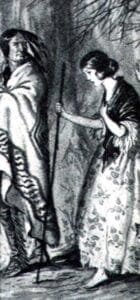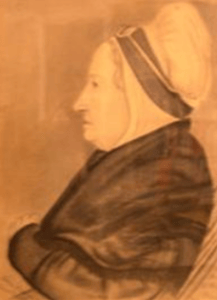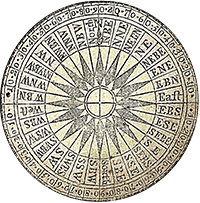Jane Bell was born at Winchester Virginia about 1735. At age 16, she married a British officer. He died sometime thereafter. In 1754, Jane Bell McClane then married John Frazier (Fraser). Frazier was a guide and interpreter for Colonel George Washington on the trip to Fort Duquesne as an emissary of Governor Dinwiddie.
After building a log dwelling which still stood just beyond the southeastern city 
Scarcely out of sight of her home, they were attacked by a group of Indians who killed and scalped her attendant, then hurried away with Jane and her horse. Jane said the Indians were kind, let her ride her horse, and they protected her from other Indians encountered during the three week journey.
The raiders returned to their village on the Great Miami River in Ohio with the captive white woman. It caused great excitement. A council was held and Jane was adapted into a tribal family. They also treated her well when she gave birth to a son (she was pregnant prior to being captured) and made the child a coffin when he later died.
Jane remained with the Indians over a year. She helped plant corn and cook, learned their ways and taught them hers, learned their language and told them stories from the Bible. During this time she witnessed preparations for another raid, the collection of food for those who remained at home, powwows, and war dances and dances to insure the success of the undertaking. The Indians brought back a Pennsylvania tanner and his son whom they adopted and appointed to tan skins.
While preparations for a third raid were being made, Jane and the two tanners escaped amid the hysterical excitement. The three traveled together for a week –then Jane, fearing capture, went on alone, living on what vegetation she could find, climbing trees or sleeping in hollows at night. After 11 days, she came to Oldtown. There she found friends.
Jane learned that her husband had searched and mourned for her for several months and had concluded she was dead. He had married a neighbor girl and they lived in his house. The friends suggested she stay with them, would get her some nice clothes, put her on a horse, and take her to her husband John, whom they felt would rejoice at her return.

John Frazier heard the approach of the party. His delight at the return of his wife was boundless as he snatched her from the horse shouting, “The lost is found… the dead is alive!” Frazier descendants say the second wife withdrew from the home and when her child was born, she brought the child to Jane, stating she wanted none of him. Jane received the child, rearing and loving him as her own.
In 1758, when Colonel Washington marched north to join Forbes Army, John and Jane Frazier went with him. They did not return to Maryland but remained in Bedford County, Pennsylvania. After the death of John Frazier, Jane married Richard DeKapt (Dunlap).
There were no other known Indian villages along the river on the grounds of what became Miami County, Ohio. This makes Jane one of the first documented female captives in northwest Ohio.
Sources:
Maryland Historical Magazine, 1953, Jane Frazier, the Allegany County Heroine, Ruth Averill Clauson.
The Scrapbook of Leonard Hill
Wikipedia
Welcome to “Sharing the Stories of History with Tim Mann”!
Meet Timothy A. Mann, a passionate historian born and raised in the heart of Shelby County, Ohio where Tim’s roots run deep in the rich soil of American history. As the author of articles and books, including “Frontier Miscellany Concerning the Miami County Ohio Militia,” “Colonel John Mann, His Kith and Kin,” and “Frontier Militia – The War of 1812,” Tim’s literary contributions have enlightened and inspired countless history enthusiasts.
Join Tim Mann on a journey through time as he shares fascinating tales, untold stories, and hidden gems from the annals of history. Let’s delve into the past together and uncover the wonders that await in “Sharing the Stories of History with Tim Mann.”



